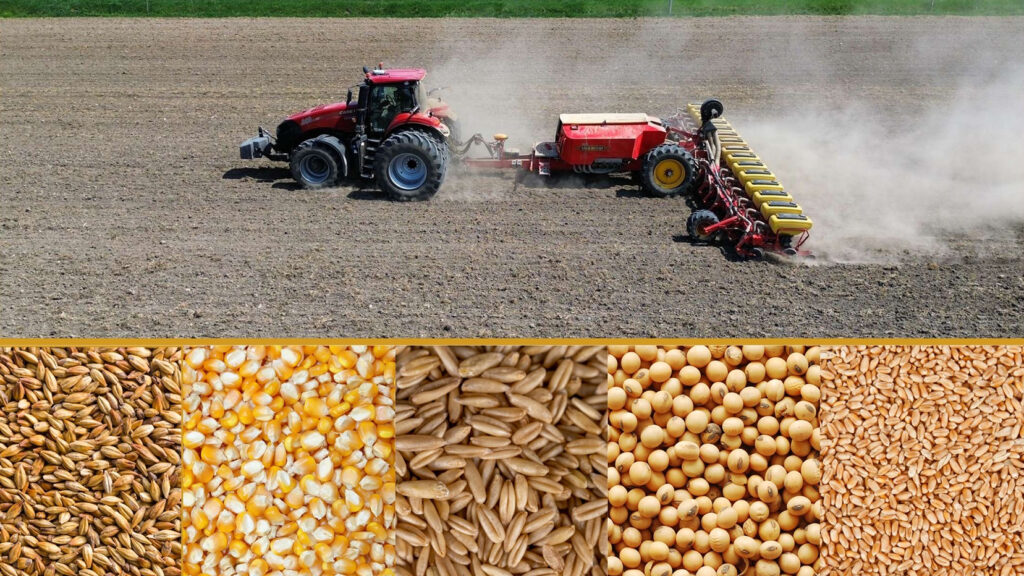How farmers choose what they grow

There are many important decisions that farmers need to make throughout the year to ensure their farms are successful. One of the decisions made by Ontario grain farmers is to choose what to grow in their fields. This decision-making process generally happens over the winter as they are planning their year ahead.
Farmers across the province all experience different conditions to grow grains, so it is important that they choose the best seeds for their farms. Certain grains will grow better in different conditions – it’s important to remember that no two fields are alike so there is a lot of planning a farmer does to decide what to grow each year.
Let’s look at some of the things farmers take into consideration when choosing what to grow!
Soil type
Across Ontario, there are four different soil types: clay, sand, silt, and a special rich soil found in the Holland Marsh. Soil type is important to consider as it can impact the availability of things such as water or nutrients that are essential for grains to grow. A sandy soil type has large pores, meaning the water will drain quickly and may not hang onto water long enough for the grain to grow. In this case, a farmer would choose a seed that may be more tolerable to dry or drought-like conditions. On the opposite end of the scale, soils heavier in clay are more likely to hang onto water, which could lead to compaction. Soil particles in clay-textured soils are very small and have small spacing between the pores. This limits water and air movement and ultimately leads to compaction. If farmers are dealing with compaction, they may want to plant corn, for example, as it has deep roots that can help break up the soil. Seed varieties that have shown strong and deep root growth would be a great choice for these soil types. So would planting a cover crop!
Crop heat units
Crop heat units are measured every day in different parts of the province. The measurements are the highest and lowest temperatures that are experienced on any given day in an area. The information that is gathered is then used to determine how much heat will be available to the grains over a growing season. This is a very important aspect farmers look at when they decide to grow their grains. Barley, corn, oats, soybeans, and wheat, grown in Ontario thrive in different conditions, with different warmth and moisture at different times throughout the year. But how does this impact what farmers grow?
Areas with lower crop heat units are found in the more northern areas of Ontario, while some of the highest heat units in the province can be found more south. Some grains, such as wheat, barley, and oats, do better in “cooler” temperature areas. In comparison, soybeans and corn need enough days at a certain warmth (22-25 ℃) to reach full maturity. In certain areas of the province, this may be difficult due to higher elevation, resulting in early frosts. When farmers are deciding what to grow, it is important to take their location in the province into consideration, as the crop heat units determine how long it may take for their grains to grow fully and healthily. For example, a farmer in the New Liskeard area may lean towards a grain seed that grows quicker, compared to a farmer in the Windsor area, who may pick one that can take longer to grow.
History of pests
There are many aspects within nature that are unpreventable but can impact the success of grain growing in Ontario. Insects, diseases, or weeds are all examples of pest organisms that can all be damaging to Ontario grains. Specific pests are often more prone in certain fields or areas.
A disease an Ontario farmer may come across is called Giberella ear rot, which impacts the ear of the corn and can greatly impact its health, making it unusable in severe cases. If an Ontario grain farmer has had issues in past corn crops with this specific disease, they may opt for a corn seed variety that has been made to fight off this disease.
Another situation where a farmer may have to make a change in the seed they grow is weeds that show up in their fields year after year. Some commonly found weeds, such as dandelion, can take a lot of the nutrients out of the soil for themselves, which leaves less available for the grains. If this is an issue for a farmer, there are some pesticides that can be applied to the dandelions to make them go away, but they can risk hurting the growing grain. If a grain farmer knows their fields are at risk for weeds, such as dandelion, they may choose a variety of seed that protect the growing plant from any liquids used to get rid of the dandelion.
These are just some of the variables farmers look into when they decide what to plant. Others may be the weather – if it is going to rain a lot in the spring, they may be delayed in planting and must change what they are going to grow. The price of their sold crop after harvest may also impact what they plant in the spring – if prices are forecasted to be low in the fall for a certain grain, they may avoid planting that grain. Or if prices are forecasted to be high in the fall, they may change their planting plans to include more acres of that grain. The end use of the grain (do they need straw on their farm?) may also impact whether they choose to grow wheat vs. corn or soybeans, for example.
There are many variables that impact how a farmer chooses what to grow each year. It is a careful balance between what will grow successfully, what will thrive on their farm, and what makes sense sustainability for both their environment and their farm business.



